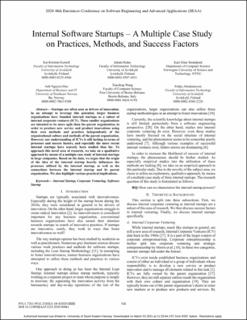| dc.contributor.author | Kemell, Kai-Kristian | |
| dc.contributor.author | Risku, Juhani Henrik | |
| dc.contributor.author | Strandjord, Kari Eline | |
| dc.contributor.author | Nguyen Duc, Anh | |
| dc.contributor.author | Wang, Xiaofeng | |
| dc.contributor.author | Abrahamsson, Pekka Kalevi | |
| dc.date.accessioned | 2021-09-28T06:24:50Z | |
| dc.date.available | 2021-09-28T06:24:50Z | |
| dc.date.created | 2021-03-02T12:43:10Z | |
| dc.date.issued | 2020 | |
| dc.identifier.isbn | 978-1-7281-9533-9 | |
| dc.identifier.uri | https://hdl.handle.net/11250/2783881 | |
| dc.description.abstract | Startups are often seen as drivers of innovation. In an attempt to leverage this potential, larger business organizations have founded internal startups as a subset of internal corporate ventures (ICV). These smaller organizations are intended to be more agile than the parent organization, in order to produce new service and product innovations using their own methods and practices independently of the organizational culture and methods of the parent organization. However, our understanding of ICVs is still lacking in terms of processes and success factors, and especially the more recent internal startups have scarcely been studied thus far. To approach this novel area of research, we take on a qualitative approach by means of a multiple case study of internal startups in large companies. Based on the data, we argue that the origin of the idea of the internal startup heavily influences the processes utilized by the internal startup, as well as the connections between the internal startup and its parent organization. We also highlight various practical implications. | en_US |
| dc.language.iso | eng | en_US |
| dc.publisher | Institute of Electrical and Electronics Engineers (IEEE) | en_US |
| dc.relation.ispartof | Proceedings of 46th Euromicro Conference on Software Engineering and Advanced Applications (SEAA 2020) | |
| dc.title | Internal Software Startups - A Multiple Case Study on Practices, Methods, and Success Factors | en_US |
| dc.type | Chapter | en_US |
| dc.description.version | publishedVersion | en_US |
| dc.rights.holder | © IEEE. Personal use of this material is permitted. Permission from IEEE must be obtained for all other uses, in any current or future media, including reprinting/republishing this material for advertising or promotional purposes, creating new collective works, for resale or redistribution to servers or lists, or reuse of any copyrighted component of this work in other works. | en_US |
| dc.identifier.doi | 10.1109/SEAA51224.2020.00061 | |
| dc.identifier.cristin | 1894893 | |
| cristin.ispublished | true | |
| cristin.fulltext | original | |
| cristin.qualitycode | 1 | |
